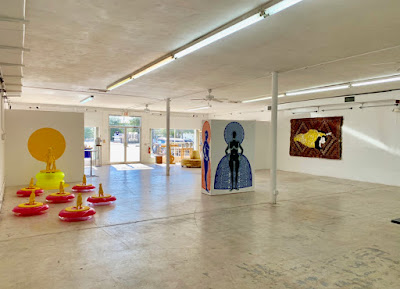CONCEPTualism 2019 | Curator Rolando Chang Barrero and essay by Andrea Iaroc
CONCEPTualism 2019
Curator: Rolando Chang Barrero
Essay by Andrea Iaroc
811 Belvedere Road
West Palm Beach, Florida 33405
Art needs a concept in order to exist.
How so? By definition, a concept is an abstract idea, a general notion, a plan or intention -- a conception. Now, how well defined that concept is and the concern within it (e.g. sociopolitical commentary), and depending on the art piece’s placement in history, it may be considered ‘Conceptual Art’ or belong to one of the 30+ art movements in art history. In contemporary art spaces, it is common to hear ‘is it art?’ in reference to Conceptual Art. Instead, I propose we ask: How is the artist trying to communicate their ideas through what we experience visually, olfactorily, tactilely, or even through sound and taste? Looking past the aesthetics of art requires a discerning eye and a curious mind. This means that as audiences, we should open our minds to what Conceptual Art offers us and enter into these conversations to transcend our ideas of what art is supposed to deal with and look like.
A concern with environmental issues and understanding of wildlife’s importance in our lives is fundamental part of Diane Arrieta’s body of work. She has a BFA in Ceramic Sculpture from Florida Atlantic University and a MSf in Wildlife Health from the University of Edinburgh. These two disciplines are smoothly syncretized in her work, although she uses a variety of media apart from ceramics. In observing her work, Sentinel, it is difficult to miss the references to the Disney version of Snow White, a coming-of-age tale first documented by Jacob and Wilhelm Grimm in 1812. In this particular work a meerkat stands guard next to the young girl, begging the thought of switching their roles: Our future planet in the hands of our young. In our current sociocultural moment of awakening, it is quite fitting that the sculpture is a girl.
Feminism, like any ideology and movement, exists in a spectrum. What was acceptable or unacceptable to second-wave feminists is not acceptable or acceptable to fourth-wave feminists, but a constant remains true: the acknowledgement of female bodies, personhoods, and identities as fully human – with rights and opportunities for all. Linda Behar goes beyond the trappings of the present and gives us tools to forge a better future through her varied artistic practice. She captures womanhood without the boundaries imposed by society, be it body shape, comportment, or any other conventions given to that role. Conventions that are also challenged by Sibel Kocabaşı in her work, as well as pressing issues of violence against women, global effects of war and migration, and environmental consciousness.
History without revisions has a lot to teach, if only proper attention is given. And yet events that should redefine our ways, are collectively forgotten and mistakes are made again – impermanent lessons. Impermanence is one of the concepts that underscore Giannina Coppiano Dwin’s work by using ephemeral materials. Her practice in general touches upon socio-cultural issues and in this particular exhibit, the #MeToo movement. At this point in history we have reckon with the fact that women are simply not believed when reporting sexual assault, violence, and abuse of power. Yet Arrieta, Behar, Kocabaşı, and Dwin not only represent feminine power and truth channeled through their work, they assert it in all its Mother Gaia greatness for everyone to see, feel, and act upon. Policy changes and societal attitudes need to change in order to actively move the current system forward.
In a world of faulty systems, denialism, paranoid conspiracies, and extreme polarities, the need to create bridges of understanding and compassion is urgent. Technology has been a key factor in these divisions but it is also the key to repair that rupture. It can help people recognize the importance of understanding climate change and its connection to increasing natural disasters, smart usage of green technology to provide alternative energy sources, and sustainable living. These ideas are hard to ignore when looking at Rick Newton’s work from the jump. Remnants of the Florida we know teem with technologically advanced structures and devices, yet crab claws seem to reign supreme over a post-apocalyptic world that signals the end of the Anthropocene epoch. And yet, his paintings have an aura of hope – not necessarily for humans but for the greater natural world that currently begs for a chance.



Comments
Post a Comment